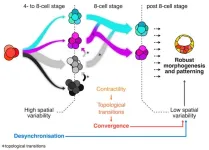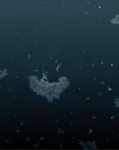(Press-News.org) Newly discovered microscopic mucus tails – trailing from particles of marine snow particles – slow these particles’ descent into the deep ocean, research finds. This doubles the particles’ residence time in the ocean's upper layers and significantly alters estimates of how much carbon is sequestered in the deep sea. The oceans serve as a vast reservoir and critical sink for atmospheric carbon dioxide. A key process driving carbon sequestration in the ocean is the biological pump, where photosynthetic activity at the ocean’s surface leads to the formation of “marine snow” – a shower of organic material falling from upper waters to the deep ocean. The steady accumulation of these particles on the ocean floor has the potential to store carbon in the deep sea for millennia. The formation of marine snow involves dynamic biogeochemical processes, and the particles’ properties, including size, shape, and sinking speed, are central to their role in carbon cycling. However, due to the biological and physical complexity of marine snow particles and a lack of direct observations, a mechanistic understanding of marine snow sedimentation has remained elusive, introducing significant uncertainties in carbon flux estimates in some climate models.
Using ship-based sediment trap sampling, scale-free vertical tracking microscopy, and a model of particle-flow interactions, Rahul Chajwa and colleagues observed the hydrodynamics of marine snow in the Gulf of Maine. Chajwa et al. discovered that marine snow particles are coated with an invisible layer of mucus, forming comet-like tails as they sink. The drag imposed by these hidden mucus tails greatly slows their sinking speed, nearly doubling the residence time of these particles in the upper ocean and reducing the amount of carbon they transport to the deep ocean for sequestration. By integrating these newly discovered dynamics into a theoretical sedimentation model, Chajwa et al. provide a more accurate understanding of marine snow sedimentation. “Chajwa et al.’s model suggests that the difference between the atmospheric carbon dioxide calculated with and without comet tails is on the order of 40 parts per million. Equivalently, the sinking particles with mucus tails sequester a couple hundred gigatonnes less carbon from the atmosphere,” write B.B. Cael and Lionel Guidi in a related Perspective. “Although such estimates are very approximate at this stage, the large magnitude change in carbon sequestration highlights the need to study this phenomenon further.”
END
Hidden “tails” slow marine snow, impacting deep sea carbon transfer and storage
Summary author: Walter Beckwith
2024-10-10
ELSE PRESS RELEASES FROM THIS DATE:
Seed dispersal “crisis” may impact plant species’ future in Europe
2024-10-10
Europe is facing a seed dispersal “crisis,” due to extinction threats and population changes among the animals that do the seed dispersing, according to a new synthesis by Sara Beatriz Mendes and colleagues. Their literature review of animal and plant dispersal pairs helped them reconstruct the first European-wide seed dispersal network. Seed dispersal by animals is a critical part of maintaining healthy ecosystems, especially in fragmented environments like those found throughout Europe. Lack of seed dispersal to connect populations could prevent declining plant populations from ...
Nitrogen deposition has shifted European forest plant ranges westward over decades
2024-10-10
Researchers have documented a shift in plant species ranges toward the poles or higher latitudes in the face of climate warming, but Pieter Sanczuk and colleagues now reveal another unexpected pattern of range shift. For decades, understory plants in European temperate forests have been on the move westward, spurred by differences in nitrogen deposition rates. Westward species distribution shifts were 2.6 times more likely than northward ones, according to the researchers, who also noted that forest canopy changes played a role in this shift as well. The findings suggest that factors beyond climate change, such as atmospheric pollution, are also an important part of redistributing biodiversity. ...
Loss of lake ice has wide-ranging environmental and societal consequences
2024-10-10
Pasadena, CA—The world’s freshwater lakes are freezing over for shorter periods of time due to climate change. This shift has major implications for human safety, as well as water quality, biodiversity, and global nutrient cycles, according to a new review from an international team of researchers led by Carnegie Science’s Stephanie Hampton.
Undertaken by scientists based in the United States, Canada, and Sweden, this analysis represents a major call-to-action for wintertime freshwater ecology research. It is published in Science.
The world has millions of freshwater lakes, most of which freeze during the winter. The team’s rigorous review indicates ...
From chaos to structure
2024-10-10
Pipetting liquids into tiny test tubes, analyzing huge datasets, poring over research publications—all these tasks are part of being a scientist. But breaking this routine is essential. Time away from the usual work environment can spark creative ideas. Lab retreats, for instance, offer a great setting where researchers can engage with other peers, often leading to new collaborations.
The latter was true for Bernat Corominas-Murtra and Edouard Hannezo from the Institute of Science and Technology Austria (ISTA). Fascinated by a dataset showcased during a poster session at a collaborative ...
Variability in when and how cells divide promotes healthy development in embryos
2024-10-10
There is variability in when and how cells divide during the development of embryos. While researchers traditionally believed this variability was an obstacle that needed to be regulated, the Hiiragi group now found that it actually promotes healthy development. The results, published in Science on 11 October 2024, encourage other scientists to see the potential of variability and could have significant impact on assisted reproductive technology.
An embryo consists of cells. These cells divide to make new cells, allowing the embryo to grow. The cells experience variability in how and when they divide and in how they interact with each other. Scientists ...
Hidden biological processes can affect how the ocean stores carbon
2024-10-10
New Stanford-led research unveils a hidden factor that could change our understanding of how oceans mitigate climate change. The study, published Oct. 11 in Science, reveals never-before seen mucus “parachutes” produced by microscopic marine organisms that significantly slow their sinking, putting the brakes on a process crucial for removing carbon dioxide from the atmosphere. The surprising discovery implies that previous estimates of the ocean’s carbon sequestration potential may have been overestimated, but also paves the way toward improving climate models and informing ...
European forest plants are migrating westwards, nitrogen main cause
2024-10-10
New research reveals nitrogen pollution, and to a lesser extent climate change, unexpectedly as the key driver behind surprising westward shifts in the distribution of plants.
A recent study has uncovered that many European forest plant species are moving towards the west due to high nitrogen deposition levels, defying the common belief that climate change is the primary cause of species moving northward. This finding reshapes our understanding of how environmental factors, and in particular nitrogen pollution, influence biodiversity.
While it is widely assumed that rising temperatures are pushing many species toward cooler, northern areas, this research shows that westward ...
Macronutrient and micronutrient intake among US women ages 20 to 44
2024-10-10
About The Study: This cross-sectional study of pregnant and nonpregnant women of reproductive age found that vitamin A, vitamin C, and iron intake decreased over the past 2 decades, which may have substantial maternal and fetal health implications. By identifying these nutrient gaps and trends in inadequate intake in this at-risk population, scientific, health care, and regulatory communities may be better poised to adopt recommendations to improve nutrient intake.
Corresponding Author: To contact the corresponding author, Derek Miketinas, PhD, RD, email dmiketinas@twu.edu.
To access the embargoed study: Visit our For The Media website ...
Payments by drug and medical device manufacturers to us peer reviewers of major medical journals
2024-10-10
About The Study: More than half of the 1,962 U.S. physicians included in this study who peer reviewed for the most influential medical journals received industry payments in 2020-2022, with most payments for research. Research payments, especially those provided to an institution, may have different implications than general payments for conflicts of interest.
Corresponding Author: To contact the corresponding author, Christopher J. D. Wallis, MD, PhD, email wallis.cjd@gmail.com.
To access the embargoed study: Visit our For The Media website at this link https://media.jamanetwork.com/
(doi:10.1001/jama.2024.17681)
Editor’s Note: Please see the article ...
One-third of cancer-related crowdfunding campaigns share medical financial hardship and health-related social needs, new research shows
2024-10-10
In a new, large comprehensive analysis led by the American Cancer Society (ACS), researchers, using a form of Artificial Intelligence (AI), found that more than one-third of fundraising stories on the GoFundMe crowdfunding platform in the United States explicitly shared experiences of medical financial hardships and health-related social needs (HRSNs). The fundraising stories included hardships such as housing and food insecurities, transportation barriers, income loss, lack of sick leave, and disruptions to both work and school. The findings are published today ...
LAST 30 PRESS RELEASES:
Exposure to natural light improves metabolic health
As we age, immune cells protect the spinal cord
New expert guidance urges caution before surgery for patients with treatment-resistant constipation
Solar hydrogen can now be produced efficiently without the scarce metal platinum
Sleeping in on weekends may help boost teens’ mental health
Study: Teens use cellphones for an hour a day at school
After more than two years of war, Palestinian children are hungry, denied education and “like the living dead”
The untold story of life with Prader-Willi syndrome - according to the siblings who live it
How the parasite that ‘gave up sex’ found more hosts – and why its victory won’t last
When is it time to jump? The boiling frog problem of AI use in physics education
Twitter data reveals partisan divide in understanding why pollen season's getting worse
AI is quick but risky for updating old software
Revolutionizing biosecurity: new multi-omics framework to transform invasive species management
From ancient herb to modern medicine: new review unveils the multi-targeted healing potential of Borago officinalis
Building a global scientific community: Biological Diversity Journal announces dual recruitment of Editorial Board and Youth Editorial Board members
Microbes that break down antibiotics help protect ecosystems under drug pollution
Smart biochar that remembers pollutants offers a new way to clean water and recycle biomass
Rice genes matter more than domestication in shaping plant microbiomes
Ticking time bomb: Some farmers report as many as 70 tick encounters over a 6-month period
Turning garden and crop waste into plastics
Scientists discover ‘platypus galaxies’ in the early universe
Seeing thyroid cancer in a new light: when AI meets label-free imaging in the operating room
Neutrophil-to-lymphocyte ratio may aid risk stratification in depressive disorder
2026 Seismological Society of America Annual Meeting
AI-powered ECG analysis offers promising path for early detection of chronic obstructive pulmonary disease, says Mount Sinai researchers
GIMM uncovers flaws in lab-grown heart cells and paves the way for improved treatments
Cracking the evolutionary code of sleep
Medications could help the aging brain cope with surgery, memory impairment
Back pain linked to worse sleep years later in men over 65, according to study
CDC urges ‘shared decision-making’ on some childhood vaccines; many unclear about what that means
[Press-News.org] Hidden “tails” slow marine snow, impacting deep sea carbon transfer and storageSummary author: Walter Beckwith




